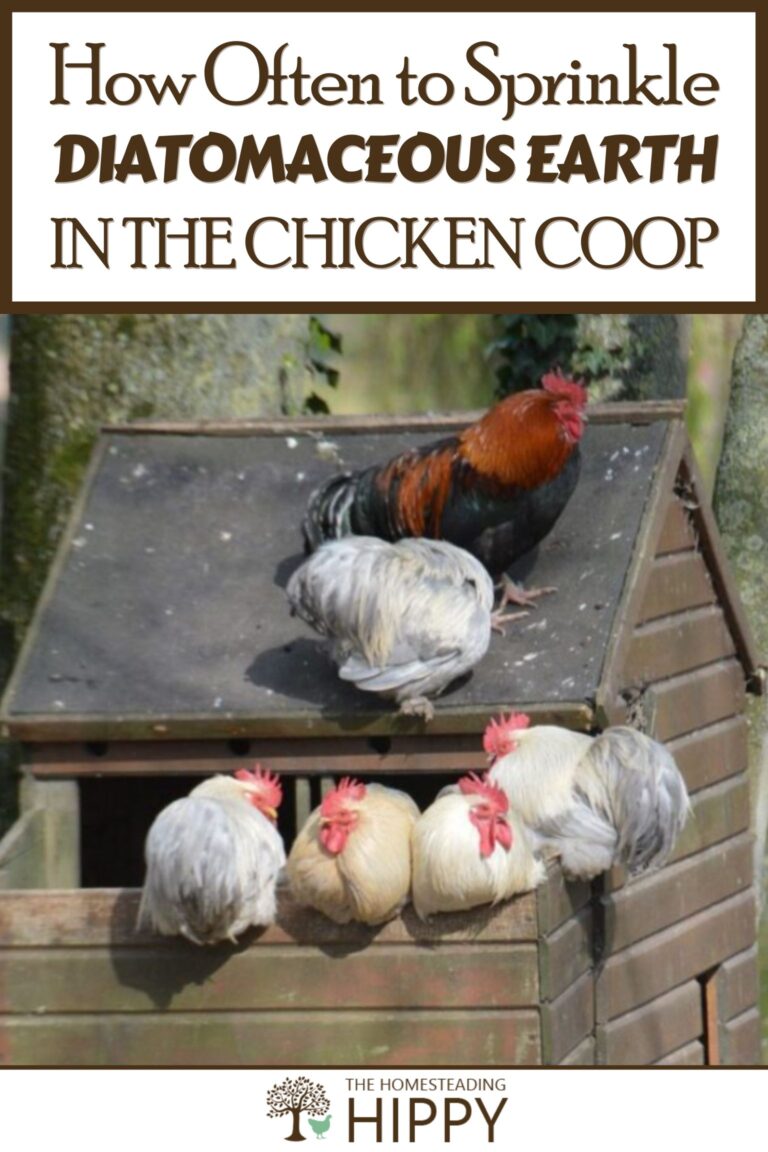Chickens are routinely the target of infestation by mites, fleas, and other tiny, biting parasites.
Much of the time these critters will take up residence in the coop and emerge at night to feast on some chickens while they sleep.
At first it is an annoyance, but over time they can spell real trouble for your flock, even endanger their lives.

One of the best defenses against pest infestation is the application of diatomaceous earth. This stuff is all-natural and easy to apply around the coop but it does not last forever.
Reapplication is necessary from time to time. But how often do you need to apply diatomaceous earth to your coop?
Apply diatomaceous earth in the chicken coop every 2 to 3 months depending on the state of the previous application, and the condition of your chickens. DE should always be reapplied immediately after washing or cleaning the coop.
Diatomaceous earth is pretty wondrous when used for eradication and prevention of pests, but it does have limits.
If you apply it too liberally or too often, it can start to irritate your chicken’s skin and respiratory system. Too little and it won’t work.
A balanced approach is needed, along with some other know-how. We will tell you what you need to know about diatomaceous earth in this article.
What is Diatomaceous Earth?
Diatomaceous earth is the fossilized remains of tiny, ancient aquatic creatures called diatoms. These diatoms had a hard outer shell made of silicone dioxide. When they died out, their shells fell to the bottom of the lake or ocean and over time, they fossilized.
These shells can be mined and ground into an abrasive powder-like substance; diatomaceous earth. The powder is then used in a variety of ways, including as an insecticide.
It is commonly sold for a variety of purposes, including as an additive in many compounds and as a standalone product for home and garden use. You can usually find it in most well-stocked hardware stores.
What Can Diatomaceous Earth do for Chickens?
Diatomaceous earth has several benefits for chickens, including as a dietary supplement and dust bath component.
But most importantly it is a safe and effective pesticide, one that works in the coop and on the chickens themselves.
When used as directed, diatomaceous earth can help to eliminate mites, fleas, ticks, and other tiny, biting creatures that typically infest chicken coops.
It is important to note that diatomaceous earth only works on contact, but it is all-natural and safe when used as directed.
How Does Diatomaceous Earth Kill Bugs?
Diatomaceous earth kills bugs in an interesting but brutal way, on a scale that the human eye cannot see.
The abrasive particles in the diatomaceous earth powder are incredibly tiny, on a microscopic level. Nonetheless, they are very hard, jagged and sharp.
When these particles come into contact with an insect, they puncture or lacerate through the hard exoskeleton, causing the bug to leak moisture and sometimes cutting up its soft insides. The results are pretty gruesome if you were to look at it under a microscope.
In this way, you can think of diatomaceous earth as a kind of mechanical pesticide. It does not rely on any chemicals or poisons to kill the pests; it just works by being incredibly abrasive and eventually dehydrating them.
Is Diatomaceous Earth Toxic? Is it Safe?
This is a common question and the answer is both yes and no. Diatomaceous earth itself is not toxic, but it can be harmful if inhaled in large quantities.
That being said, you are unlikely to ever encounter a problem as long as you take some basic precautions when using it and use common sense when applying it.
Do note that there are usually several grades of diatomaceous earth sold commercially, and some of them have a high silica content which can be a big problem for you and your chickens over time.
So long as you purchase a food-grade type with low or no silica, it is not much to worry about. More on that in a minute.
How Often Should You Apply Diatomaceous in the Coop?
You should apply diatomaceous earth in the coop every 2 to 3 months as a preventative and control measure, and more often if you have an active infestation.
As we mentioned before, it is important to not overdo it as this can irritate your chickens’ skin or lungs.
How Do You Apply Diatomaceous Earth?
You apply diatomaceous earth as powder by brushing or rubbing in onto surfaces, into cracks and crevices, and by mixing it in with bedding and other dry substrates.
You can even make a wash of diatomaceous earth in water and mop or spray it on, though it will not take effect as quickly; it needs to be dry to function.
Also, be as thorough as you can. Diatomaceous earth only works if the pests come into direct contact with it, so make sure to cover every single crack, crevice, surface, and hiding place in the stuff for maximum benefit.
What Variety of Diatomaceous Earth Should You Use?
Not all diatomaceous earth is created equal. It is important that you use food or livestock-grade diatomaceous earth, and not the type sold for swimming pools, filters, or other purposes.
The main difference is that food-grade diatomaceous earth has a much lower amount of crystalline silica; below 1%. In contrast, other types can have up to 80% crystalline silica.
This is important because significant or long-term exposure to high levels of crystalline silica can cause serious respiratory problems in both humans and animals.
So it is best to avoid it if you can, and food-grade diatomaceous earth is totally effective and readily available online and in most farm or hardware stores.
Just pay attention to the specific ratios on the label and you’ll be fine. If in doubt, consult the MSDS to be sure.
Warning: Diatomaceous Earth Can Cause Respiratory Issues
Be sure to wear a dust mask when applying diatomaceous earth, as it can be harmful if inhaled in large quantities. It is also a good idea to do this in a well-ventilated area if possible. If you cannot, wear a respirator.
When applying diatomaceous earth to or around your chickens, be sure not to get any in their eyes, and cover their head if you can. Diatomaceous earth can cause serious eye irritation, so it is best to avoid getting it in there.
Limitations of Diatomaceous Earth
Diatomaceous earth is a great option for pest control, but not a perfect one. First, as we mentioned before, it only works when dry.
If it gets wet, it will sometimes clump up and in any case, will not be effective until it dries out. This is why it is best to apply diatomaceous earth in a powder form, and to do so on a dry day.
Consider reapplication a good idea if the area where it has been applied is cleaned, washed, or experiences hard rain.
Second, diatomaceous earth does not discriminate between pests and non-pests. So, if you have other insects in or around your coop that are beneficial diatomaceous earth will kill them as well.
This is why it is important not to overdo it, and only use diatomaceous earth as needed for specific problems.
Last, diatomaceous earth does not work quickly. Compared to traditional pesticides or insecticide baths, it will take weeks for diatomaceous earth to kill all the pests in an area.
So, if you have a major infestation, you may want to consider using another method as well, at least at first, before switching to.
Diatomaceous earth is a great option for pest control in your chicken coop and run. It is safe for chickens, relatively inexpensive, and easy to apply.
And, while it does have some limitations, used correctly it can be a very effective way to keep your coop and flock pest-free.

Tom has built and remodeled homes, generated his own electricity, grown his own food and more, all in quest of remaining as independent of society as possible. Now he shares his experiences and hard-earned lessons with readers around the country.
Find out more about the team here.
